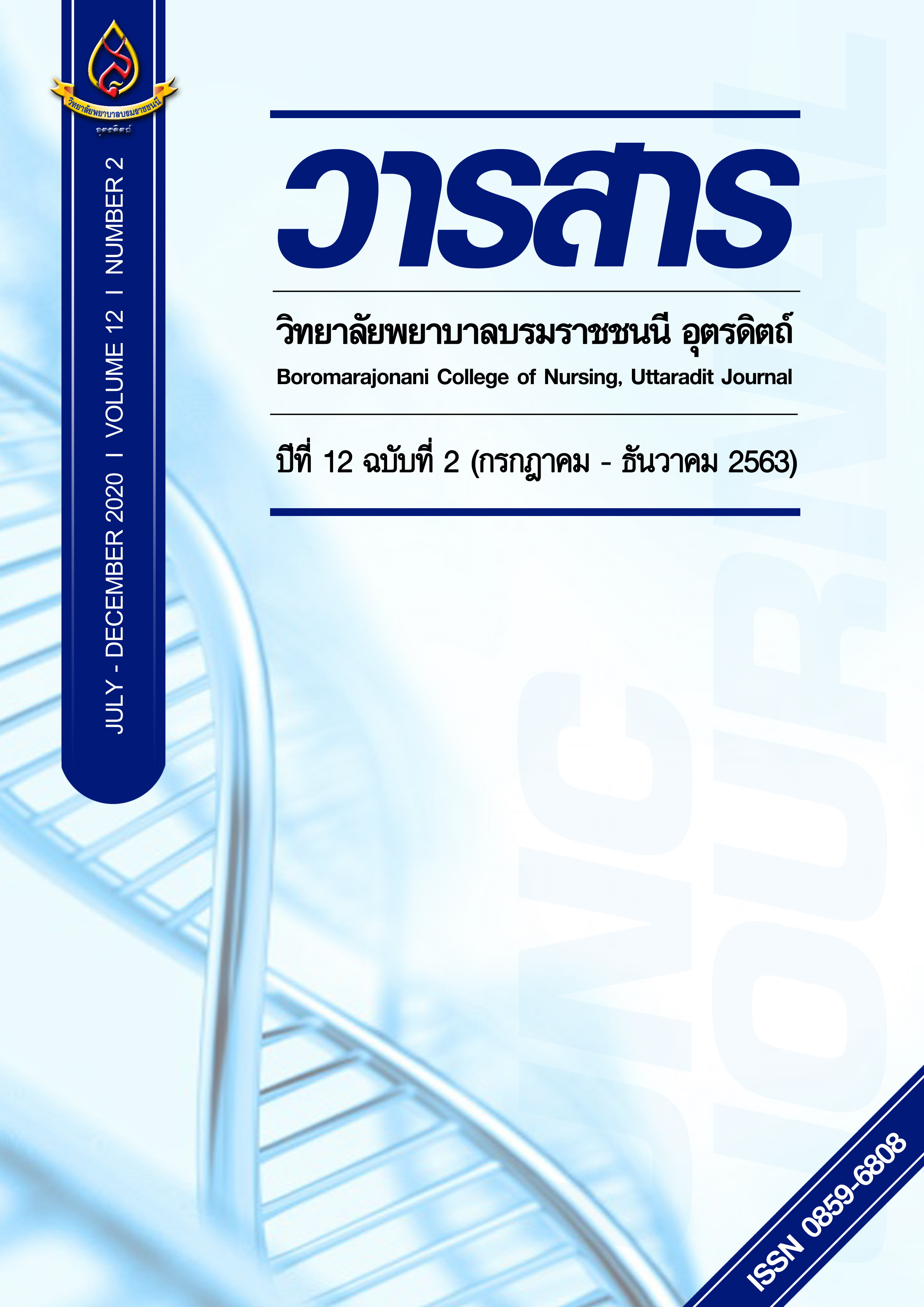ผลการจัดการเรียนการสอนโดยใช้บทบาทสมมติในสถานการณ์จำลองต่อความรู้ ทักษะและทัศนคติ การรับส่งเวรด้วยเทคนิค SBAR ของนักศึกษาพยาบาลศาสตรบัณฑิตชั้นปีที่ 4 วิทยาลัยพยาบาลบรมราชชนนี เชียงใหม่
Main Article Content
บทคัดย่อ
การวิจัยนี้เป็นการวิจัยกึ่งทดลอง(Quasi-Experimental Research) แบบ 2 กลุ่ม มีกลุ่มควบคุม (two group with control group) มีวัตถุประสงค์เพื่อทดสอบความแตกต่างของค่าเฉลี่ยคะแนนความรู้ ทักษะและทัศนคติการรับส่งเวรด้วยเทคนิคSBAR (Situation, Background, Assessment, Recommendation) ของนักศึกษาพยาบาลที่ได้รับการสอนโดยใช้บทบาทสมมติในสถานการณ์จำลองกับการบรรยาย กลุ่มตัวอย่าง คือ นักศึกษาพยาบาลชั้นปีที่ 4 วิทยาลัยพยาบาลบรมราชชนนี เชียงใหม่ จำนวน 68 คน โดยการสุ่มตัวอย่างแบบเฉพาะเจาะจง (purposive sampling) เป็นกลุ่มทดลองและกลุ่มควบคุม เครื่องมือที่ใช้ในการวิจัย คือ แผนการสอนการรับส่งเวรทางการพยาบาลด้วยเทคนิค SBAR แบบวัดความรู้ แบบวัดทักษะ และแบบประเมินทัศนคติการรับส่งเวรทางการพยาบาลด้วยเทคนิค SBAR ที่ผู้วิจัยสร้างขึ้น ตรวจสอบความตรงตามเนื้อหาโดยผู้ทรงคุณวุฒิ หาค่าความเชื่อมั่นของแบบวัดความรู้ ทักษะ และทัศนคติ มีค่าสัมประสิทธิ์อัลฟาของครอนบาคเท่ากับ .86 , .84 และ .91 ตามลำดับ สถิติที่ใช้ในการวิเคราะห์ข้อมูล คือ ค่าเฉลี่ย ค่าเบี่ยงเบนมาตรฐานและใช้สถิติทดสอบที
ผลการวิจัย พบว่า 1) ค่าเฉลี่ยคะแนนความรู้และทักษะในการรับส่งเวรทางการพยาบาลด้วยเทคนิค SBAR ของนักศึกษาพยาบาลกลุ่มที่ได้รับการสอนโดยใช้บทบาทสมมติในสถานการณ์จำลองสูงกว่ากลุ่มที่ได้รับการสอนโดยใช้การบรรยาย แตกต่างกันอย่างมีนัยสำคัญทางสถิติที่ระดับ .05 และ 2) ค่าเฉลี่ยคะแนนทัศนคติด้านการจัดการเรียนการสอนในการรับส่งเวรทางการพยาบาลด้วยเทคนิค SBAR ของนักศึกษาพยาบาลกลุ่มที่ได้รับการสอนโดยใช้บทบาทสมมติในสถานการณ์จำลองสูงกว่ากลุ่มที่ได้รับการสอนโดยใช้การบรรยายอย่างมีนัยสำคัญทางสถิติที่ระดับ .05 จากผลการศึกษานี้อาจารย์พยาบาลสามารถนำวิธีการใช้บทบาทสมมติในสถานการณ์จำลองไปใช้ในการจัดการเรียนการสอนการรับส่งเวรทางการพยาบาลด้วยเทคนิค SBAR เพื่อพัฒนาความรู้และทักษะการรับส่งเวรทางการพยาบาลให้เกิดประสิทธิภาพสูงสุดและสามารถนำไปประยุกต์ใช้ได้เมื่อสำเร็จการศึกษาในอนาคต
Article Details
บทความหรือข้อคิดเห็นใดใดที่ปรากฏในวารสารวิจัยการพยาบาลและวิทยาศาสตร์สุขภาพ เป็นวรรณกรรมของผู้เขียน ซึ่งบรรณาธิการหรือสมาคมศิษย์เก่า ไม่จำเป็นต้องเห็นด้วย และบทความที่ได้รับการตีพิมพ์เผยแพร่ถือเป็นลิขสิทธิ์ของวารสารวิจัยการพยาบาลและวิทยาศาสตร์สุขภาพ
เอกสารอ้างอิง
Anthony, M.K., & Preuss, G. (2002). Models of care: The influence of nurse Communication on patient safety. [Electrical version]. Nursing Economics, 20(5), 209-215.
Ascano-Martin F. (2008). Shift report and SBAR: strategies for clinical post-Conference. Nurse Education today, 33(5), 190-191.
Charuwanno, R., Wongchanglor, J. & Pongsananurak, T. (2014). Effects in teaching by using SBAR technique on knowledge attitude and practice in taking and giving report among nursing students. Journal of The Royal Thai Army Nurses, 3, 390-397. (in Thai).
Collins, G. (2014). Using simulation to development handover skills. [Electrical version]. Nurse Times, 110(8), 12-14.
Erfanian, F. Khadivzadeh, T., Khadem, N.& Khajedelooie, M. (2009). The effect of teaching by role playing on students’ counseling and screening skills toward IUD clients. [Electrical version]. Iranian Journal of Medical Education, 8(2), 275-283.
Fatemeh. V., Fereshteh, D., Mahboobeh, M. & Seyed Mohammad J. S. (2016). Effects of applying role playing approach on nursing students’ education. [Electrical version]. International Journal of Humanities And Cultural Studies (IJHCS). ISSN 2356-5926.
Girdley, D., Johnson, C.& Kwekkeboom K. (2009). Facilitating a culture of safety and patient-centered care through use of a clinical assessment tool in undergraduate Nursing education. [Electrical version]. Journal Nurse Education, 48(12), 702-705
Janpilom, N., Sengsri, S. & Kongmanus, K. (2018). Attitudes of nursing Instructors and students towards simulation based learning in The subject of nursing practice. Boromarajonani College of Nursing, Uttaradit Journal, 10(2), 222. (in Thai).
Kelman, H. C. (1967). Human use of human subjects: The problem of deception in social psychological experiments. [Electrical version]. Psychological Bulletin, 67, 1-11.
Kesten, KS. (2011). Role-play using SBAR technique to improve observed communication skill in senior nursing students. [Electrical version]. Journal of Nursing Education, 50(2), 79-87. PMid: 21210611
Khemmani, T. (2012). Sadkason. (Phim khrang thi 4) [The Science of Teaching. (4thed.)]. Bangkok: Chulalongkorn University Press. (in Thai).
Lancaster RJ, Westphal J. &Jambunathan J. (2015). Using SBAR to promote clinical Judgment in undergraduate nursing students. [Electrical version]. Journal of Nursing Education, 54(3 Suppl.), 31-34. PMid: 25692739
Leonard, M., Graham, S. & Bonacum D. (2004). The human factor: The critical Importance of effective teamwork and communication in providing Safe care. [Electrical version]. Quality Safe Health Care, 13, 185-190.
Mi Yu & Kyung ja Kang. (2017). Effectiveness of a role-play simulation program involving the SBAR technique: A quasi-experimental study. [Electrical version]. Nursing Education Today, 53, 41-47.
Narges, T.C., Shahnaz, A., & Shahnaz, A. (2014). Comparision the effect of teaching of SBAR technique with role play and lecturing on communication skill of nurses. [Electrical version]. Journal of Sciences, 3(2), 141-147.
Rachel, S. (2015). Role-play and student engagement: reflections from the classroom.[Electrical version]. Teaching in Higher Education, 20(5), 481-492.
Rafii, F., Oskouie, F., Mohammadi, R., Yarandi, A. F., Peyrovi, H.& Haghani H. (2007). Caring behaviors of student nurses following clinical experience through Role play and traditional method. [Electrical version]. Iran Journal of Nursing, 20(50), 7-19.
Raines, M. (2007). Give it to me: The development of a tool for shift change report in a Level I Trauma Center. [Electrical version]. Journal of Emergency Nursing, 33, 358-360.
Riesenberg, L. A., Leitzsch, J., & Cunningham, J. M. (2010). Nursing handoffs: A systematic review of the literature. [Electrical version]. The American Journal of Nursing, 110(4), 24-34.
Tipmontree, S. (2013). Effectiveness of role playing in an “English for hospitality services” Classroom. Faculty of Liberal Arts and Management Science: Prince of Songkla University, Thailand. (in Thai).
Weiwen Wang, Zhan Liang, Alice, & Brian Greene. (2015). Improving Chinese nursing students’ Communication skills by utilizing video-stimulated recal and role-play case scenarios to introduce them to the SBAR technique. [Electrical version]. Nursing Education Today, 53(7), 881-887.
World Health Organization [WHO]. (2007). Communication During Patient Hand-overs. Retrieved (2020, April 9) from http://bit.ly/ecCnXg


